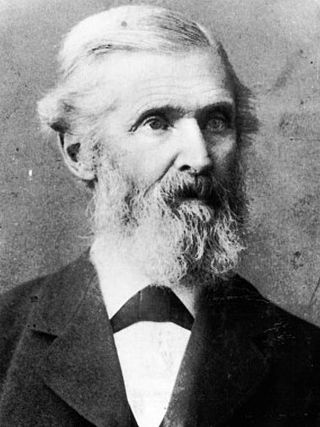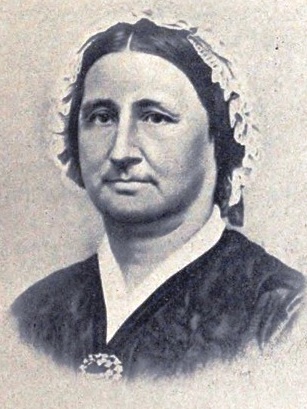
Brigham Young was an American religious leader and politician. He was the second president of the Church of Jesus Christ of Latter-day Saints from 1847 until his death in 1877. During his time as church president, Young led his followers, the Mormon pioneers, west from Nauvoo, Illinois, to the Salt Lake Valley. He founded Salt Lake City and served as the first governor of the Utah Territory. Young also worked to establish the learning institutions that would later become the University of Utah and Brigham Young University. A polygamist, Young had at least 56 wives and 57 children. He formalized the prohibition of black men attaining priesthood, and led the church in the Utah War against the United States.

John Taylor was an English-born religious leader who served as the third president of the Church of Jesus Christ of Latter-day Saints from 1880 to 1887. He is the first and so far only president of the LDS Church to have been born outside the United States.

Ann Eliza Young also known as Ann Eliza Webb Dee Young Denning was one of Brigham Young's fifty-five wives and later a critic of polygamy. Her autobiography, Wife No. 19, was a recollection of her experiences in the Church of Jesus Christ of Latter-day Saints. She grew up in a polygamous household which moved to Utah during the Mormon migration. Ann Eliza was married and divorced three times: first to James Dee, then Young, and finally Moses Denning. Her divorce from Young reached a national audience when Ann Eliza sued with allegations of neglect, cruel treatment, and desertion. She was born a member of the LDS Church, but was excommunicated shortly after her public divorce from Young.

Ezra Taft Benson was an apostle and a member of the Quorum of the Twelve Apostles of the Church of Jesus Christ of Latter-day Saints.

Abraham Owen Woodruff was an American missionary who was a member of the Quorum of the Twelve Apostles of the Church of Jesus Christ of Latter-day Saints. He was also the son of LDS Church president Wilford Woodruff.

Parley Parker Pratt Sr. was an early leader of the Latter Day Saint movement whose writings became a significant early nineteenth-century exposition of the Latter Day Saint faith. Named in 1835 as one of the first members of the Quorum of the Twelve Apostles, Pratt was part of the Quorum's successful mission to Great Britain from 1839 to 1841. Pratt has been called "the Apostle Paul of Mormonism" for his promotion of distinctive Mormon doctrines.

Brigham Young Jr. served as president of the Quorum of the Twelve Apostles of the Church of Jesus Christ of Latter-day Saints from 1899 until his death. His tenure was interrupted for one week in 1901 when Joseph F. Smith was the president of the Quorum.

The Beehive House was one of the official residences of Brigham Young, the second President of the Church of Jesus Christ of Latter-day Saints, in Salt Lake City, Utah, United States. The Beehive House gets its name from the beehive sculpture atop the house.

Orson Spencer was a prolific writer and prominent member of the Church of Jesus Christ of Latter-day Saints. He served in several highly visible positions within the church and left an extensive legacy of theological writings. Orson Spencer is one of the examples William Mulder cites of highly educated people becoming Mormons during the time of Joseph Smith

Truman Osborn Angell was an American architect who served many years as the official architect of The Church of Jesus Christ of Latter-day Saints. The brother-in-law of Brigham Young, he was a member of the vanguard company of Mormon pioneers that entered the Salt Lake Valley on July 24, 1847. He designed the Salt Lake Temple, the Lion House, the Beehive House, the Utah Territorial Statehouse, the St. George Utah Temple, and other public buildings. Angell's modifications to the Salt Lake Tabernacle are credited with perfecting the acoustics for which the building is famous.

Joseph Standing was a missionary for the Church of Jesus Christ of Latter-day Saints who was killed by a mob near the town of Varnell, Whitfield County, Georgia, in 1879.

Mary Ann Angell Young was the second woman married to Brigham Young, who served as president of the Church of Jesus Christ of Latter-day Saints. Young's first wife had died in 1832, leaving Young a widower. Angell and Young were married on March 31, 1834, in Kirtland, Ohio. Angell eventually gave her consent to the practice of plural marriage after Young's marriage to Lucy Ann Decker, his first plural wife. Angell remained married to Young until his death in 1877, and together they had six children.

Joseph Angell Young was an apostle of the Church of Jesus Christ of Latter-day Saints. Young is one of the few Latter-day Saints in history to have been ordained to the office of apostle without ever becoming a member of the Quorum of the Twelve Apostles or the First Presidency.

John Riggs Murdock was a Mormon pioneer, Utah politician, and leader of the Church of Jesus Christ of Latter-day Saints in Beaver, Utah. He is sometimes credited as the leader of the most down-and-back companies in Latter-day Saint history, as he directed multiple ox-drawn wagon trains sent from Utah to bring back both merchandise and emigrating church members from back East. Murdock also served several missions in the eastern United States.

John Parry Sr. was an early Welsh convert to the Church of Jesus Christ of Latter-day Saints and was the first musical conductor of the Mormon Tabernacle Choir.

Margaret Young Taylor was a member of the inaugural general presidency of the Young Ladies' National Mutual Improvement Association, now the Young Women organization of the Church of Jesus Christ of Latter-day Saints from 1880 to 1887. She was one of the plural wives of John Taylor, a president of the LDS Church.

Edwin Dilworth Woolley Sr. was a Mormon pioneer, an early Latter-day Saint bishop in Salt Lake City, and a businessman in early Utah Territory who operated mills.

Possibly as early as the 1830s, followers of the Latter Day Saint movement, were practicing the doctrine of polygamy or "plural marriage". After the death of church founder Joseph Smith, the doctrine was officially announced in Utah Territory in 1852 by Mormon leader Brigham Young. The practice was attributed posthumously to Smith and it began among Mormons at large, principally in Utah where the Church of Jesus Christ of Latter-day Saints had relocated after the Illinois Mormon War.

Hiram Bradley Clawson was a Latter-day Saint businessman and Church leader in the 19th and early 20th centuries.




















